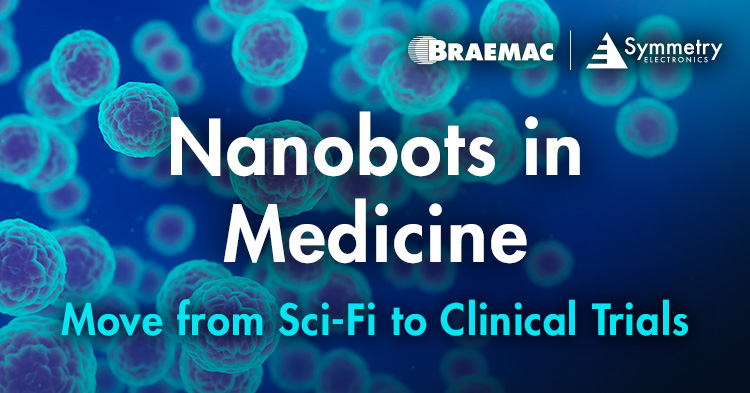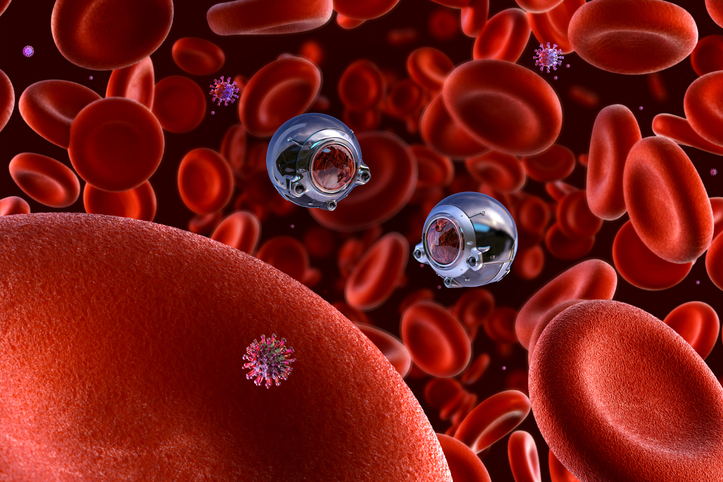- Home
- Braemac Blog
- Nanobots in Medicine Move from Sci-Fi to Clinical Trials
Nanobots in Medicine Move from Sci-Fi to Clinical Trials
About Jari Haiston

Michael Crichton’s popular techno-thriller Prey imagined swarms of rogue nanobots evolved beyond human control. While Crichtonian nanobots do lean into highly intelligent design, his vision was steeped in paranoia and speculative danger. The truth is that the nanobots of today are far cry from a sci-fi nightmare. Their journey from fiction to fact is not guided by destruction, but by healing.
From targeted drug delivery to tumor detection, nanobots are emerging as medical marvels now progressing into clinical trials. These microscopic machines bring an unprecedented level of accuracy to diagnosis, treatment, and monitoring. Researchers worldwide are exploring nanorobotics as a new era of nanomedicine that promises more personalized and effective medical interventions than ever before.
Adopting Nanotechnology in Medical Sectors
To understand nanobots in medicine, it’s important first to grasp the broader concept of nanotechnology.
Historically, Richard Feynman is credited as the “father of nanotechnology.” Though Feynman didn’t build nanotech devices himself, his vision inspired future generations of scientists and engineers. Nanotechnology itself refers to the science and engineering of materials, devices, and systems at the nanoscale (typically between 1 and 100 nanometers). For context, a nanometer is one-billionth of a meter. At this scale, materials can exhibit unique electrical, optical, mechanical, and biological properties that differ dramatically from their behavior at larger scales. These distinctive behaviors form the foundation of nanomedicine.
Early theoretical work by scientists such as K. Eric Drexler in the 1980s and Robert Freitas Jr. in the 1990s envisioned medical nanorobots capable of repairing cells, delivering drugs, or even acting as artificial red blood cells. Later, Adriano Cavalcanti contributed practical proposals for medical nanorobotics, focusing on potential hardware architectures. His research outlined how nanorobots could integrate wireless energy platforms and teleoperation systems, enabling long-distance control and data transfer for healthcare applications.
What Are Nanobots in Medicine?
Essentially, a nanobot (or nanorobot) in medicine is a tiny robot purpose-built to perform tasks at the nanometer scale. Medical nanobots are engineered to respond to specific stimuli inside the human body. Often no larger than a microbe, they’re engineered from biocompatible components and programmed for a specific medical function.Despite their microscopic footprint, nanorobotic design is quite sophisticated:
- Sensors to detect surroundings
- Actuators that perform actions like moving or releasing a drug
- Structural shell or frame made from biocompatible materials like DNA origami, proteins, or synthetic polymers
- Propulsion mechanism such as microscopic cilia, chemical thrusters, or magnetic-responsive elements
- Onboard control unit which can be as simple as a chemical logic gate or as complex as a nano-scale electronic processor
- Power sources like nanoscale battery or energy harvesting components
- Communication units to send/receive signals and data

Moreover, many nanobot designs are envisioned to operate autonomously or semi-autonomously. For instance, a nanobot might travel through the bloodstream, home in on a tumor by sensing its unique chemical signals and then carry out a task like delivering a payload or destroying malignant cells.
To accomplish this, nanobots leverage various types of control and propulsion. Some designs use external signals like magnetic fields, ultrasound waves, or light to guide movements. Others are actually powered by chemical reactions in the body, using local fuels like glucose or enzymes to propel them.
It’s easy to think of medical nanorobots as tiny submarines navigating the body, complete with navigation systems, engines, sensors, and a “mission” payload – all miniaturized to a scale hundreds of times smaller than a cell.
Real-World Applications of Medical Nanobots
Fast forward to today, and nanobots in medicine are still in the experimental stage and not yet in routine clinical use. However, researchers have made significant progress in lab and animal trials. The challenge of navigating the human body safely and effectively has been a major barrier, though progress is steady. For instance, USask scientists recently succeeded in moving micro/nano-robots through the tiny blood vessels of animals and are refining control models to optimize navigation in bloodstream flow.
In China and Hong Kong, a team has been experimenting with microrobotic therapy for sinus infections. In 2023, a team created tiny helical robots (smaller than a hair’s width) that can be injected into the sinuses to clear out bacterial infection, then be flushed out through the nose once their job is done.
While we’re still years away from seeing nanobots in everyday clinical practices, organizations are still heavily investing in medical nanobot initiatives. In 2022, the team responsible for creating Apple’s Face ID, Bionaut Labs, closed its series B funding round with $43.2 million to accelerate their drug delivery robot project into preclinical trials.
One of the reasons nanobots are so promising is the wide range of medical applications they could support. Researchers are actively exploring nanobot applications in:
- Targeted Drug Delivery
- Smart Drug Delivery Systems
- Cancer Treatment Nanobots
- Nanosurgery Techniques

The potential advantages of using nanobots in medicine are truly compelling. If researchers can overcome the challenges, nanorobotic approaches offer several key benefits over traditional medical techniques. Operating at the scale of cells and molecules, they can distinguish and target specific problem areas without affecting the rest of the body. Treatments could be tailored to an individual’s exact condition. For example, instead of blasting the whole body with a chemotherapy drug, a swarm of nanobots could precisely deliver therapy to a cluster of tumor cells and nowhere else.
Nanobots could also enable greater overall efficiency through minimally invasive procedures. We’ve already seen the benefits of robotics in surgery, but nanobot procedures could replace major surgeries, allowing patients to recover faster with less pain and risk.
Supporting the Future of Connected Healthcare with Solutions Available at Braemac Americas
The potential impact of nanobots on healthcare is nothing short of revolutionary. If and when these devices become common in medical practice, they could fundamentally change how we approach disease, injury, and healthcare overall.
As a leader in wireless and IoT, Braemac Americas (rebranded from Symmetry Electronics) is uniquely positioned to understand just how crucial connectivity is in the future of biotech, especially in nanomedical innovations. Our curated portfolio includes best-in-class solutions to support the next generation of connected healthcare.



.png)
